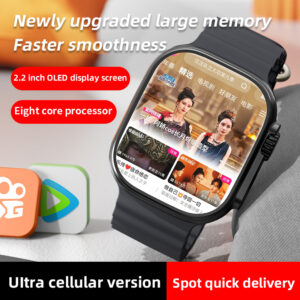2024-07-27
In an era of rapid technological advancement, various smart products emerge incessantly, and smartwatches undoubtedly hold a significant position in the watch market. As people’s demands for quality of life continue to rise, smartwatches are increasingly favored by consumers for their powerful functionalities. So, what are the differences between smartwatches and ordinary watches? Let’s delve into it together!
Smartwatches integrate intelligent systems and connect to networks, enabling multifunctionality by synchronizing with smartphones to access features such as calls, messages, emails, photos, and music. Currently, smartwatches on the market can be broadly categorized into two types: 1) Fashionable smartwatches without calling capabilities, relying on smartphone connectivity for multifunctionality, and 2) Children’s smartwatches with calling capabilities, supporting SIM card insertion, essentially resembling smartphones in watch form. Most of these smartwatches use the Android system, with some offering compatibility with Apple systems.
On the other hand, watches, also known as timepieces or wristwatches, are instruments worn on the wrist for timekeeping and displaying the time. Watches typically feature straps made of materials like leather, rubber, nylon, or stainless steel, securing the time-displaying “watch face” to the wrist. Thus, a wristwatch is simply another term for a watch.
Compared to ordinary watches, the value of smartwatches lies more in their perception and interaction with the human body. Smartwatches function more like sensors rather than computational centers. Many common design elements among smartwatches include curved shapes, vibrant colors, absence of hands, and engineering plastics. These dynamic elements embody the passion and vitality of a smartwatch. In contrast, traditional watches emphasize simplicity and practicality, directly expressing their two most valuable functions—accessory and timekeeping—to users. The understated, high-tech sophistication of traditional watches is precisely where their charm lies.
Smartwatches incorporate digital product features and trendy fashion elements into timekeeping and value-added services, setting them apart from ordinary watches. They are more suitable for young people and casual occasions. In contrast, ordinary watches primarily focus on accessorizing and timekeeping, offering relatively simpler functionalities and representing a realm of luxury for mid-to-high-end consumers. Consumers who purchase ordinary watches seek more cultural and quality aspects.
Although smartwatches currently tend to be higher priced compared to traditional watches due to their early development stage, the difference in price seems acceptable when compared to traditional watches.
As for the choice between smartwatches and ordinary watches, it shouldn’t be a major controversy. Smartwatches offer more powerful and geek-friendly functionalities, while ordinary watches are pricier and boast aesthetically pleasing designs. Different consumers have different preferences, and there’s no need to debate which one might replace the other, as they belong to entirely different fields fundamentally.
Currently, smartwatches overall still appear relatively rudimentary, with bulky sizes and unsatisfactory battery life. However, considering the developmental trajectory of smartphones, improvements in materials and craftsmanship will undoubtedly drive continuous progress in this new product category.
At present, the biggest challenge for smartwatches lies in the contradiction between screen quality and battery life. If one desires a battery life of over a week, options like Pebble with black-and-white screens are available. However, for more complex functionalities and attractive OLED or LCD screens, the battery of a typical smartwatch generally lasts only a day.
Therefore, whether it’s choosing between smartwatches and ordinary watches or between color screens and black-and-white screens, there’s no standard answer at the moment. Smartwatches need further development, and what consumers need most is to understand what they truly want.


